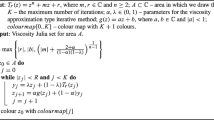Abstract
In this paper, we analyze the theory of the Julia set (J set) of Newton’s method, construct the Julia sets of Newton’s method of function \(F(z)=ze^{z^{w}}\) (w∈ℂ) through iteration method, and analyze the attracting region of the two fixed points 0 and ∞ when w are different values. Consequently, we draw the following conclusions: (1) When the judge conditions for the iterative algorithm are changed to |N(z n )−z n |≤EOF, the properties of the figures in our experiments are contrary to the conclusions in (Wegner and Peterson, Fractal Creations, pp. 168–231, 1991); (2) The attracting regions of the fixed points 0 and ∞ for w=2n (n=0,±2,±4,…) are symmetrical about x-axis and y-axis; select the main argument to be in [−π,π), for arbitrary w=α (α∈ℂ), the attracting regions of the fixed points 0 and ∞ are symmetrical about the x-axis; (3) The attracting regions of the two fixed points 0 and ∞ of J set for w=±η have rotational symmetry of η times; (4) If w=−4.7, k=0.8, then the attracting regions of different magnifications display a startling similarity, J set holds infinite self-similar structures; (5) When w is a complex number, because the selection of main argument θ z in the negative x-axis is not continuous, the fault and rupture of the attracting regions of the two fixed points 0 and ∞ appear only in the negative x-axis.
Similar content being viewed by others
References
Holmgren, R.A.: A First Course in Discrete Dynamical Systems, pp. 107–188. Springer, New York (1996)
Kneisl, K.: Julia sets for the super-Newton method, Cauchy’s method, and Halley’s method. Chaos 11(2), 359–370 (2001)
Wang, X.Y.: Fractal Mechanism of General M-J Sets, pp. 10–58. Dalian University of Technology Press, Dalian (2002)
Wegner, T., Peterson M.: Fractal Creations. The Waite Group Press, Mill Valley (1991), pp. 168–231
Walter, D.J.: Systemised serendipity for producing computer art. Comput. Graph. 17(6), 699–700 (1993)
Moonja, J., Gi, O.K., Seong, A.K.: Dynamics of Newton’s method for solving some equations. Comput. Graph. 26(2), 271–279 (2002)
Gilbert, W.J.: The complex dynamics of Newton’s method for a double root. Comput. Math. Appl. 22(10), 115–119 (1991)
Gilbert, W.J.: Newton’s method for multiple roots. Comput. Graph. 18(2), 227–229 (1994)
Gilbert, W.J.: Generalizations of Newton’s Method. Fractals 9(3), 251–262 (2001)
Wang, X.Y., Liu, W.: The Julia set of Newton’s method for multiple roots. Appl. Math. Comput. 172(1), 101–110 (2006)
Wang, X.Y., Liu, B.: Julia sets of the Schröder iteration functions of a class of one-parameter polynomials with high degree. Appl. Math. Comput. 178(2), 461–473 (2006)
Chen, N., Zhu, X.L., Chung, K.W.: M and J sets from Newton’s transformation of the transcendental mapping \(F(z)=e^{z^{w}+c}\) with vcps. Comput. Graph. 26(3), 371–383 (2002)
Çilingir, F.: On infinite area for complex exponential function. Chaos Solitons Fractals 22(5), 1189–1198 (2004)
Çilingir, F.: Finiteness of the area of basins of attraction of relaxed Newton method for certain holomorphic functions. Int. J. Bifurc. Chaos 14(12), 4177–4190 (2004)
Curry, J., Garnett, L., Sullivan, D.: On the iteration of rational functions: Computer experiments with Newton’s method. Commun. Math. Phys. 91, 267–277 (1983)
Ralston, A., Rabinowitz, P.: A First Course in Numerical Analysis. McGraw-Hill, New York (1978), pp. 73–122
Blancharel, P.: Complex analytic dynamics on the Riemann sphere. Bull. Am. Math. Soc. 11(1), 88–144 (1984)
Wang, X.Y., Wang, T.T.: Julia sets of generalized Newton’s method. Fractals 15(4), 323–336 (2007)
Milnor, J.: Dynamics in One Complex Variable-Introductory Lectures, 2nd edn., pp. 16–98. Vieweg, Wiesbaden (2000)
Wang, X.Y., Yu, X.J.: Julia set of the Newton transformation for solving some complex exponential equation. Fractals 17(2), 197–204 (2009)
Wang, X.Y., Song, W.J., Zou, X.L.: Julia set of the Newton method for solving some complex exponential equation. Int. J. Image Graph. 9(2), 153–169 (2009)
Author information
Authors and Affiliations
Corresponding author
Rights and permissions
About this article
Cite this article
Wang, XY., Li, YK., Sun, YY. et al. Julia sets of Newton’s method for a class of complex-exponential function F(z)=P(z)e Q(z) . Nonlinear Dyn 62, 955–966 (2010). https://doi.org/10.1007/s11071-010-9777-4
Received:
Accepted:
Published:
Issue Date:
DOI: https://doi.org/10.1007/s11071-010-9777-4




